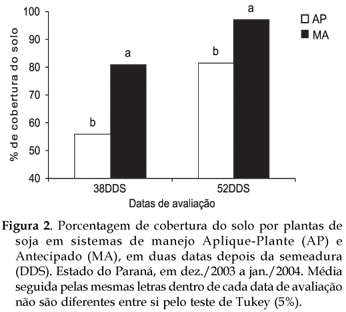The choice of the adequate moment for the desiccation of the green cover that precedes the sowing is fundamental for the success of no-till soybeans. This context, the work was aimed to study two burndown systems: desiccation immediately before sowing (AP) and anticipated desiccation (MA), composed by two burndown herbicide applications. For MA, the first application of glyphosate (1240 g ha-1) occurred between 30 and 35 days before the sowing of the crop, and the second was done just before sowing. For AP, the applications (1080 to 1260 g ha-1 of glyphosate) occurred within 48 hours prior to sowing. The trials were developed in 2003/2004 growing season, in six localities in Paraná State: Sertãozinho, Campo Mourão, Iretama, Pitanga, Boa Esperança, and Mamborê, in areas with high density of weeds preceding no-till soybean sowing. Evaluations related to weed control and soybean development and grain yield were performed. MA burndown systems provided improved control of weeds after crop emergence. Soybean plants from AP areas were shorter, in comparison to ME, evidencing a delay in the shoot growth. Reduction of grain yield was verified for all localities when AP burndown system was adopted, with reductions between 15% and 50%.
desiccation; Glycine max; weeds; integrated management; no-till













